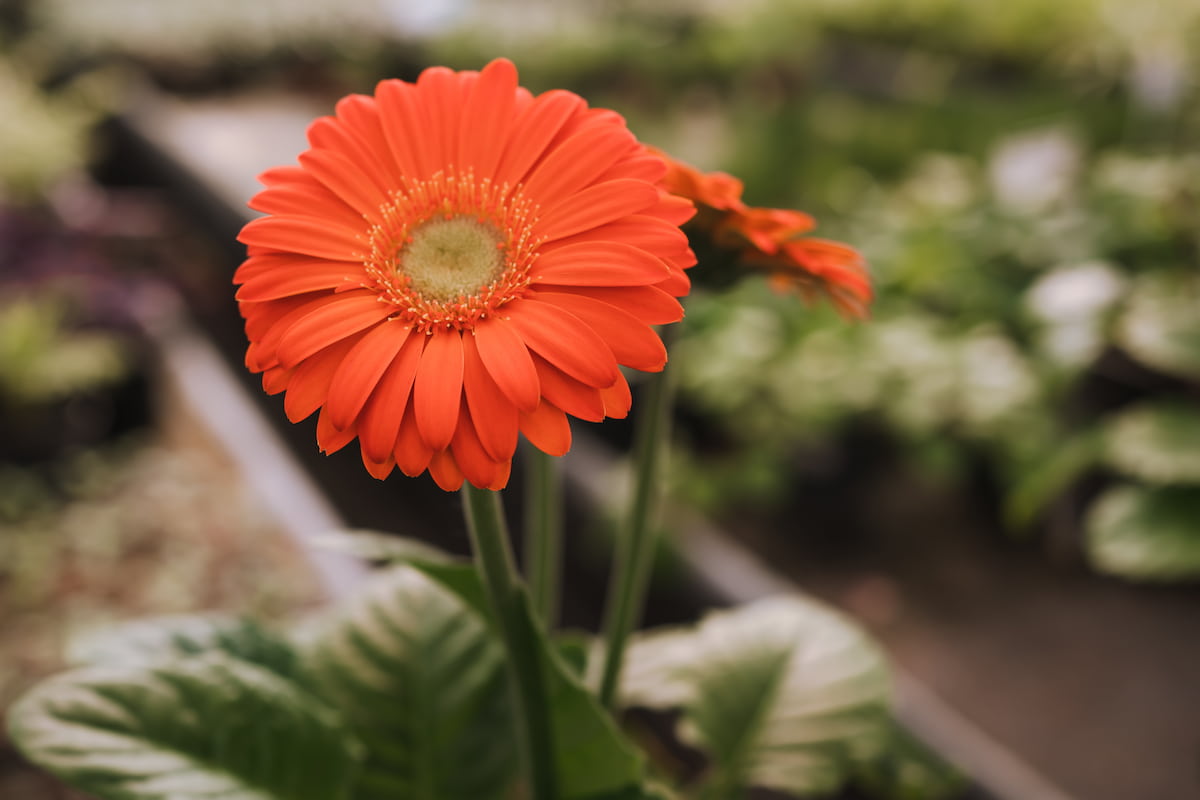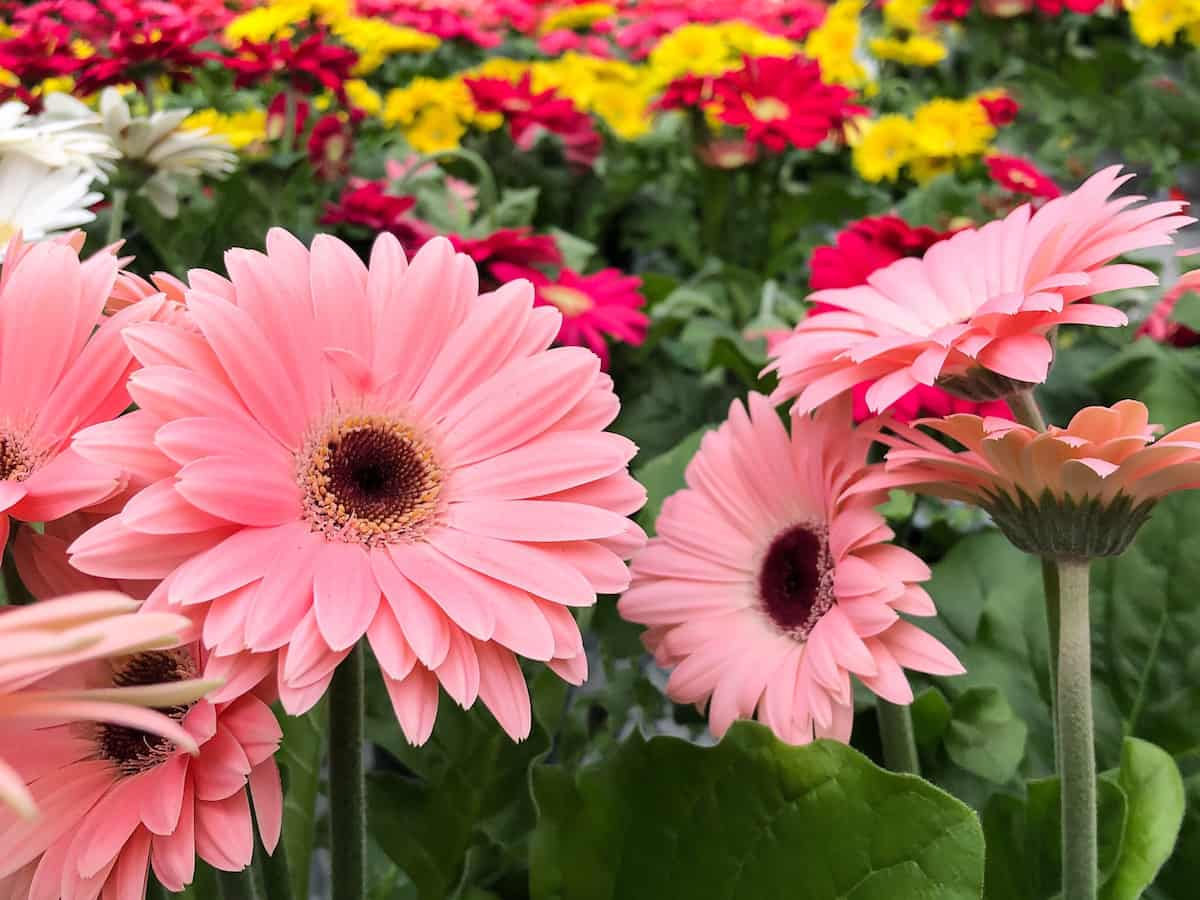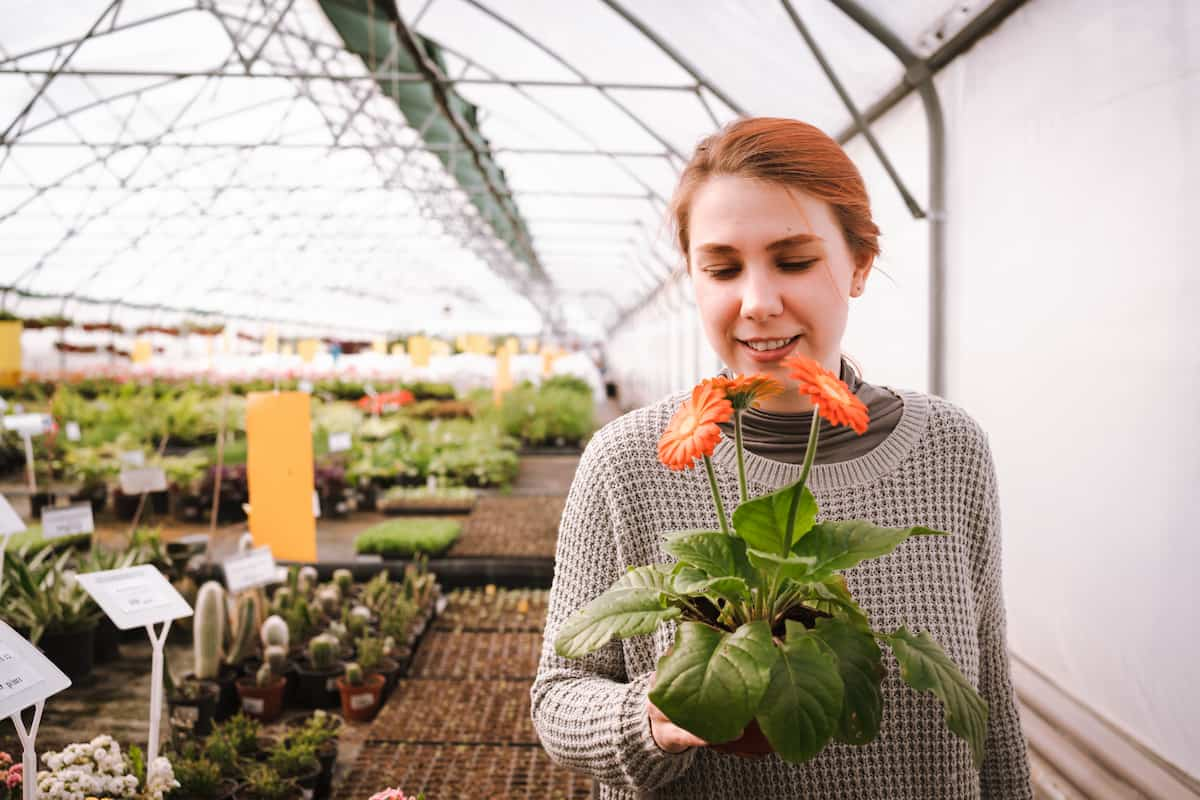Gerbera flowers, which grow in sunny South Africa, are part of the Aster family, including sunflowers. Each bloom consists of a halo of petals surrounding a ring of tiny flowers in the center. Gerberas come in various hardiness levels, but you typically grow them as half-hardy annuals outdoors or as perennials in a greenhouse, depending on the variety you choose.

How to Grow Gerberas in Greenhouse
Varieties of Gerberas
| Name of the Variety | Color |
| Ruby Red, Sangaria, Dusty, Salvadore, Red Impulse, Fredorella, Tamara, Shania and Vesta | Red |
| Doni, Mammut, Supernova, Talasa, Nadja, Uranus, Panama, Fredking, Fullmoon | Yellow |
| Marasol, Orange Classic, Kozak, Goliath, Carrera | Orange |
| Treasure, Black Jack | Purple |
| Rosalin, Salvadore | Rose |
| Terraqueen, Valentine, Marmara, Esmara, Pink Elegance | Pink |
| Farida, Winter Queen, Snow Flake, Dalma | Cream |
| White Maria, Delphi | White |
Climate for Growing Gerbera in Greenhouse
Gerbera plants grow well in tropical and subtropical climates. In sub-tropical climates, however, they must be protected from frost as they are sensitive to it. Subtropical regions generally cultivate them in greenhouses. Natural ventilation is essential for greenhouses. For good quality Gerbera flowers, a light intensity of 400 watts/m2 with a day temperature of 22-250C and a night temperature of 12-160C is the most ideal.
Soil Requirements for Growing Gerberas in Greenhouse
Gerbera cultivation and production require a well-drained, rich, light, neutral, or slightly alkaline soil (pH 6.5 to 8.0). Gerbera roots grow 50-70 cm deep. For better root growth and penetration of roots, the soil should be highly porous and well-drained, up to 50 cm deep. Plowing the land 2-3 times deep should achieve a fine tilth. Prepare raised beds 30 cm high and 1 -1.2 meters wide, leaving 30-50 cm between them. A 2:1:1 proportion of FYM, sand, and coconut peat/paddy husk should be added to the beds.
How to Plant Gerbera Seeds in Greenhouse
- Prepare seedling trays by filling them with damp potting soil.
- Plant the seed with the hardened end down and the fuzzy side up until the top of the seed is just below the soil line.
- After you have filled the seedling tray, cover it with clear plastic and place it in a sunny location with an average temperature of 21°C. Consider using grow lights if the sun is a problem.
- Moisture but not too much moisture should be maintained in the soil.
- Upon growing seeds and sprouting leaves, move them to a sunny location and pot them.
- You can plant the bloom in the garden after the plant has adjusted to the new conditions.
How to Plant a Gerbera From Division in Greenhouse
- Watering the plant with one inch of water a day or two before you divide them.
- Mix about two inches of peat or compost with the soil on top of the area where you plan to plant the new Gerbera.
- Dig up the root ball of your original Gerbera plant using a garden spade (about 8 inches deep).
- Use pruning shears to cut through the roots after brushing off the soil. Make sure each Gerbera division has a healthy crown and roots before dividing.
- Ensure the crown of the Gerbera division is at ground level when replanting it in the new area. The divisions should be spaced 12 to 18 inches apart.
- Water the soil with one inch of water and keep it moist for several months.
Water Requirements for Growing Gerberas in Greenhouse
Gerbera plants require approximately 700 mL of water per day. When the roots are established, they need a regular water supply. This means they must be irrigated daily for a month following planting. A month is needed for the roots to become firmly established. In the following days, irrigation must be done every alternate day. It is generally the drip irrigation method used to irrigate Gerbera fields.
In case you missed it: How to Grow Dragon Fruit in a Greenhouse: A Step-By-Step Guide for Seed to Harvest

Fertilizing Requirements for Growing Gerberas in Greenhouse
It is necessary to constantly feed the soil a 17-5-17 fertilizer at 150-200 ppm during the growing season to maintain a soil EC of 1.75 to 2.0. The use of a 20-10-20 fertilizer under high-light conditions is also recommended. Phosphorus and iron should be supplied at 8-12 ppm each. During winter, calcium-based fertilizers are recommended, but ammonium fertilizers may also be needed. Keep an eye on your pH level. Ideally, the pH should be between 5.5 and 5.8. When the pH reaches 6.5, Gerberas will show signs of iron and manganese deficiencies. The leaves will have a mottled appearance at this point.
Weeding Practises in Gerbera Farming in Greenhouse
Gerbera farming is plagued by competition from other plants. For the first three months of the plantation, weeding must be carried out every fortnight. Following this, the weeding is done on a monthly basis. There are a few basic wedding practices that are followed:
- Plucking old leaves to allow new ones to grow
- The soil around the plant area should be raked and loosened to allow air to circulate.
- Gerbera buds that develop within the first two months should be removed. It is essential to allow later-produced buds to bloom.
Common Pests and Plant Diseases in Gerberas
Whiteflies, thrips, aphids, and spider mites feed on Gerbera leaves. Maintain a healthy plant and monitor it regularly for signs of trouble since they are attracted to stressed plants. Insecticidal soap or natural horticultural oils like neem will control larger populations, while a strong water spray will eliminate small populations.
Leafminers can also infest Gerbera leaves. Remove any damaged leaves that show signs of tunneling. When soil is wet, plants can be affected by powdery mildew, crown rot, and root rot. Allow the soil to dry between one watering to the next, but do not let the flowers go for too long without water, as they may wilt and become stressed.
Harvesting Greenhouse Grown Gerberas
Gerbera starts producing plantation buds after 30 to 45 days, but these buds are inferior. Therefore, the bud at the base of the flower stalk should be removed. Disbudding makes the plant stronger and healthier. It took 80 – 85 days to perform this operation. The first flowers are harvested 12-14 weeks after planting (85-90 days).
The stalk of the good Gerbera flower is 45-55 cm long, and its diameter is 10-12 cm. Harvesting Gerbera flowers is best done in the morning or evening. Harvesting requires skilled labor. A bucket filled with clean water is used to store harvested flowers. Flowers are very delicate; therefore, they should be handled carefully. There are approximately 45 flowers produced per year by one Garbera plant.
In case you missed it: How to Grow Cardamom in a Greenhouse: A Step-By-Step Guide for Seed to Harvest

Conclusion
Known botanically as Gerbera Jemesonii, Gerbera is a natural herb. The flower stalks are long, thin, and leafless. During warm, humid weather, it flowers all year long. Gerbera can also be grown in raised beds in the open air, in a greenhouse under controlled conditions (protected cultivation), and in pots.
- Feed Your Flock for Less: Top 10 Tips to Save on Chicken Feed
- Ultimate Guide to Ossabaw Island Hog: Breeding, Raising, Diet, and Care
- Hatching Answers: The Top 10 Reasons Your Chickens Aren’t Laying Eggs
- Eggs and Economics: Breaking Down the Cost of Raising Backyard Chickens
- Defend Your Greens: Proven Methods to Keep Iguanas Out of Your Garden
- Ultimate Guide to Cinnamon Queen Chicken: A Comprehensive Guide for Beginners
- Ultimate Guide to California Tan Chicken: Breeding, Raising, Diet, Egg-Production and Care
- Ultimate Guide to Marsh Daisy Chicken: Breeding, Raising, Diet, and Care
- 10 Types of Chicken Farming Businesses You Can Start for Profits